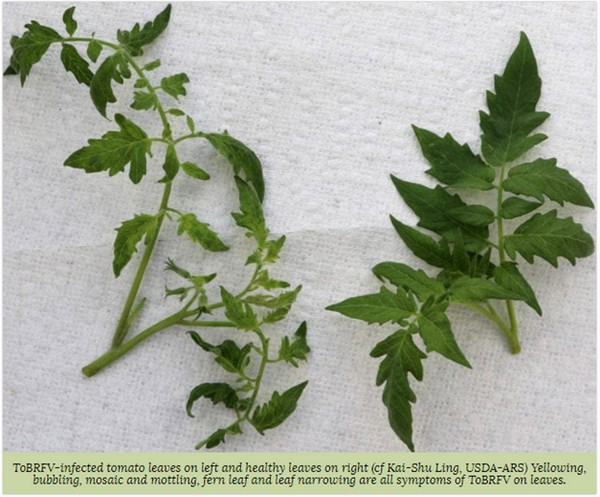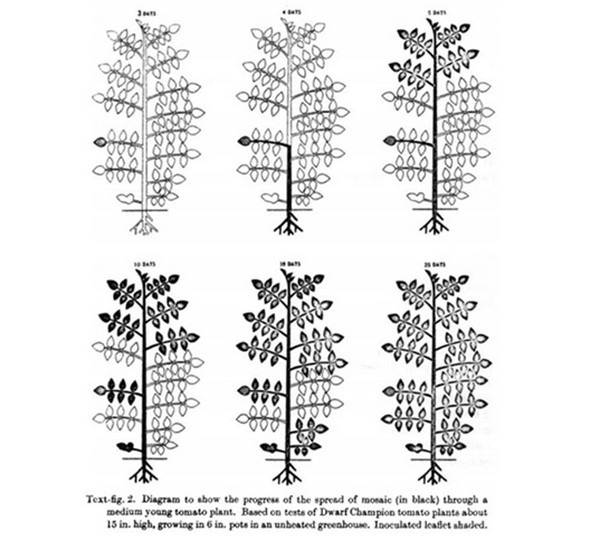By Harmen Hummelen; Field Quality Lead
The tomato brown rugose fruit virus (ToBRFV) is now so widely distributed that it is very likely to eventually reach all global production locations. As some people say, it is not a question of 'if,' but 'when'. As a grower, it is therefore important to be prepared and ready to understand the virus infection or manage its spread or potential outbreak.
ToBRFV infection that are not managed properly can have a big impact on plant quality and yield. You will certainly remember the first time you see virus symptoms on your plants. Hopefully you will detect the virus very soon after infection, and this article presents some tips and suggestions for early detection.
Recognizing in the greenhouse
Early infection is not easy to recognize, partly because most people have not personally seen the disease before. There are some general guidelines to aid early detection and recognition of ToBRFV, and a good scout who can 'read' the plants is the most valuable tool.
A good scout or grower is most likely to see those plants which are not 'normal' for the particular variety or that time of the year (for example those having a slightly different color or shape). Those symptoms may not be directly linked to ToBRFV because the symptoms can often look like fertilizer deficiency or other stress factors.
For instance, one of the symptoms can be that the plant is a little shorter, without a clear reason. Those plants, or their neighbors, may have fruits which are not ripening in the normal way. Some fruits, particularly at the top of a truss, are later ripening or the ripening is more uneven, perhaps with a little more blotchiness. Maybe the top of the plant is a little bit paler in green color? These are all symptoms that can be caused by many factors, but which can also indicate ToBRFV.
One problem is that in some cases, the virus causes no plant symptoms and only shows on the fruits. This seems to occur especially in older crops, where hardly any symptoms are seen, but the virus is present. This increases the risk of a missed infection going on to the next crop cycle.
It is therefore very important that if something does not look or feel normal, to start thinking about the possibilities and check again more carefully. The final step to determine whether ToBRFV is present is to carry out a diagnostic test.

A good and easy method to test the presence of ToBRFV is sampling the calyx of the fruit
by Leonie Hogendonk; Market Development Protected Lead
Testing
A laboratory test or a quick test can demonstrate indication of infection. In both cases, we need to make sure to collect several plant parts, for instance, the calyx and active growing shoots in a single sample because virus may not be present in all parts of the plant. In case the first sample does not confirm the visual diagnosis do not hesitate to generate another sample from a second plant or combine multiple plants in one sample. https://research.wur.nl/en/publications/detection-of-tomato-brown-rugose-fruit-virus-is-influenced-by-inf
Drain water diagnosis is also a good way to find an infection early. Growers in Belgium have tested this water using laboratory analysis, and in some cases a virus infection can be detected up to 10 weeks before visual symptoms are seen.
Be careful with testing at the beginning of the season after a previous infection because it is possible that dead virus RNA from last season may be detected. However, if cases of the virus increase, then it is clear there is living virus increasing in the plants.
Detection of the virus should be narrowed down to a certain block or section of the greenhouse, and such early detection allows you to take extra measures and therefore reduce the spread of the virus in the greenhouse or nursery.
 Figure 1. Virus is not evenly distributed over the whole plant. A virus enters the plant somewhere and then moves with phloem to the roots. At almost the same time it also moves to the young active growing top of the plant, and it can take some time before the rest of the plant is infected.
Figure 1. Virus is not evenly distributed over the whole plant. A virus enters the plant somewhere and then moves with phloem to the roots. At almost the same time it also moves to the young active growing top of the plant, and it can take some time before the rest of the plant is infected.
The movement of Tobacco Mosaic Virus within the plant. G. Samuel 1934: https://onlinelibrary.wiley.com/doi/abs/10.1111/j.1744-7348.1934.tb06891.x
Route of virus entry into the greenhouse
When the first plants are detected, the next question is, 'why did infection start at this spot?' In practice, it is not always possible to clarify this. The virus is invisible, and even with good preventative measures and hygiene, low levels can be introduced at a certain moment. The location showing the virus does not have to be the entry point.
The virus can enter on people, material, or animals. It is currently unknown how long is required for the virus to infect the crop from the vector (whatever is carrying the virus) and may be anything from 10 minutes to a day or longer. This means the virus may first show up in the middle of the greenhouse, even if it was introduced elsewhere. The virus also needs a plant which is susceptible enough to allow infection to occur.
All those unknown factors make it difficult to trace the initial entry point. For that reason, it is very important to have high levels of greenhouse and crop hygiene right from the start and during the growing season.
Backtracking from infection date
In some experiments, virus symptoms show up in young plants after just 10 days. However, in older plants it is possible that no clear symptoms are seen for months, or even until the end of cultivation. Therefore, finding this first plant is a big challenge. It is most likely that the first plant already infected is one of the neighboring plants and by the time a scout finds symptoms, the infection may include 10-20 plants in total.
Good scouting to find the virus as early as possible, and good hygiene to reduce virus spreading, are key to keep as many plants as possible healthy until the end of the crop cycle.
This is article was prepared by Harmen Hummelen and Leonie Hoogdonk and is #1 from our Bayer's Growing with ToBRFV: A new reality series
Stay tuned for part 2 of this series on ToBRFV on virus prevention after detection will be published shortly
For more information:
Bayer
www.bayer.com
